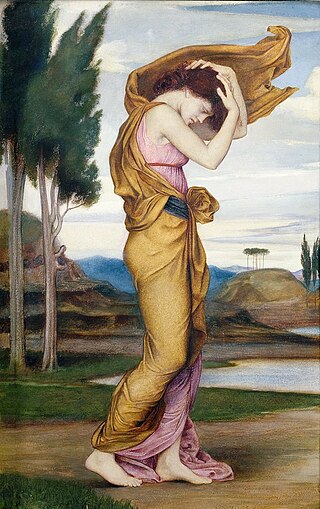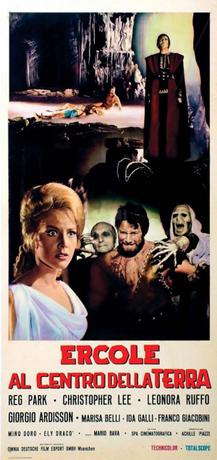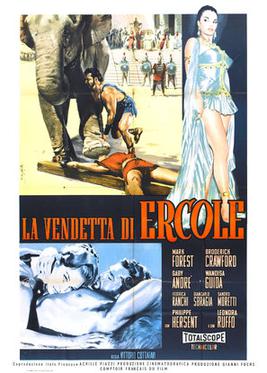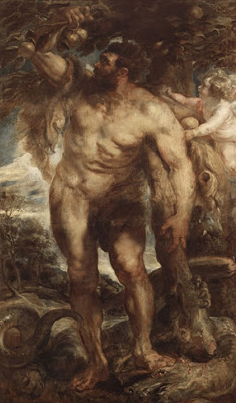
Hercules is the Roman equivalent of the Greek divine hero Heracles, son of Jupiter and the mortal Alcmena. In classical mythology, Hercules is famous for his strength and for his numerous far-ranging adventures.

Heracles, born Alcaeus or Alcides, was a divine hero in Greek mythology, the son of Zeus and Alcmene, and the foster son of Amphitryon. He was a great-grandson and half-brother of Perseus, and similarly a half-brother of Dionysus. He was the greatest of the Greek heroes, the ancestor of royal clans who claimed to be Heracleidae (Ἡρακλεῖδαι), and a champion of the Olympian order against chthonic monsters. In Rome and the modern West, he is known as Hercules, with whom the later Roman emperors, in particular Commodus and Maximian, often identified themselves. The Romans adopted the Greek version of his life and works essentially unchanged, but added anecdotal detail of their own, some of it linking the hero with the geography of the Central Mediterranean. Details of his cult were adapted to Rome as well.

Deianira, Deïanira, or Deianeira, also known as Dejanira, is a Calydonian princess in Greek mythology whose name translates as "man-destroyer" or "destroyer of her husband". She was the wife of Heracles and, in late Classical accounts, his unwitting murderer, killing him with the poisoned Shirt of Nessus. She is the main character in Sophocles' play Women of Trachis.

In Greek mythology, Iole was the daughter of King Eurytus of Oechalia. According to the brief epitome in the Bibliotheca, Eurytus had a beautiful young daughter named Iole who was eligible for marriage. Iole was claimed by Heracles for a bride, but Eurytus refused her hand in marriage. Iole was indirectly the cause of Heracles' death because of his wife's jealousy of her.

In Greek mythology, Lichas was Heracles' servant, who brought the poisoned shirt from Deianira to Hercules because of Deianira's jealousy of Iole, which killed him.

Antonio del Pollaiuolo, also known as Antonio di Jacopo Pollaiuolo or Antonio Pollaiuolo, was an Italian Renaissance painter, sculptor, engraver, and goldsmith, who made important works in all these media, as well as designing works in others, for example vestments, metal embroidery being a medium he worked in at the start of his career.

In Greek mythology, Nessus was a famous centaur who was killed by Heracles, and whose poisoned blood in turn killed Heracles. He was the son of Centauros. He fought in the battle with the Lapiths and became a ferryman on the river Euenos.

In Greek mythology, the Shirt of Nessus, Tunic of Nessus, Nessus-robe, or Nessus' shirt was the poisoned shirt that killed Heracles. It was once a popular reference in literature. In folkloristics, it is considered an instance of the "poison dress" motif.

Hercules in the Haunted World is a 1961 Italian sword-and-sandal film directed by Mario Bava. British bodybuilder Reg Park plays Hercules while British actor Christopher Lee appears as Hercules' nemesis Lico. Shooting at Cinecittà, director Mario Bava used some of the same sets from the earlier Hercules and the Conquest of Atlantis which also stars Park.
Hercules in the Underworld is the fourth television movie in the syndicated fantasy series Hercules: The Legendary Journeys.

The Loves of Hercules is a 1960 international co-production film starring Jayne Mansfield and her then husband Mickey Hargitay. The film was distributed internationally as Hercules vs. the Hydra.

Hercules in the Vale of Woe, a.k.a. Hercules in the Valley of Woe, is a 1961 Italian Franco and Ciccio comedy film directed by Mario Mattoli and starring Kirk Morris as Maciste and Frank Gordon as Hercules. The film is a comical take on the popular sword-and-sandal epics of the 1950s and 1960s.
The tale known as "The Poison Dress" or "Embalmed Alive" features a dress that has in some way been poisoned. This is a recurring theme throughout legends and folktales of various cultures, including ancient Greece, Mughal India, and the United States. Although lacking evidence suggesting that some American urban legends are directly linked to the classical tales, they share several common motifs.

Goliath and the Dragon is a 1960 international co-production sword-and-sandal film starring Mark Forest and Broderick Crawford. The name of the main character was changed from Hercules to Emilius for release in North America by American International Pictures to sell it as a sequel to their earlier Goliath and the Barbarians (1959).
Achelous and Hercules is a 1947 mural painting by Thomas Hart Benton. It depicts a bluejeans-wearing Heracles wrestling with the horns of a bull, a shape the protean river god Achelous was able to assume. The myth was one of the explanations offered by Greco-Roman mythology for the origin of the cornucopia, a symbol of agricultural abundance. Benton sets the scene during harvest time in the U.S. Midwest.

Deianira Listens to Fame or Deianira delivering the fatal tunic to the Fury is a 1638 oil painting on canvas. It is now in the Sabauda Gallery in Turin. It is a pendant to another Rubens painting, Hercules in the Garden of the Hesperides. It shows Hercules' wife Deianira and another woman holding a tunic soaked in the blood of Nessus, which Deianira believed would make Hercules to be forever true to her but instead killed him.

Hercules in the Garden of the Hesperides is a 1638 painting by Peter Paul Rubens. It measures 246 cm by 168.5 cm and is now in the Sabauda Gallery in Turin. It shows Hercules in the Garden of the Hesperides and forms part of a pair with the same artist's Deianira Listens to Fame.

Hercules Oetaeus is a fabula crepidata of c. 1996 lines of verse which survived as one of Lucius Annaeus Seneca's tragedies. It tells the story of Hercules' betrayal by his jealous wife, Deianira, followed by his death and apotheosis. The general opinion is that the play is not Seneca's, but was written in close imitation.

Hercules Killing the Stymphalian Birds is a 1500 tempera on canvas painting by Albrecht Dürer, now kept in the Germanisches Nationalmuseum in Nuremberg.

The Signs of the Zodiac is a series of twelve allegorical paintings of the signs of the Zodiac, originally painted around 1640 by Jacob Jordaens and bought by the French Senate in 1802 for the ceiling of the East Gallery of the Palais du Luxembourg in Paris. The paintings represent the signs of the zodiac through stories from Greek and Roman mythology.

















